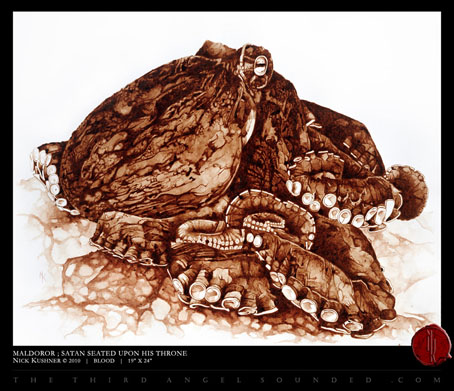Artist Nick Kushner writes to alert me that his 2010 painting Maldoror: Satan Seated Upon His Throne has been used on the cover of a recent Russian edition of Lautréamont’s novel. Kushner uses his own blood to create his paintings, and the cover below has been created using the same material. Maldoror himself would no doubt demand that proper homage be paid by binding the volume in human skin. That’s something publisher Provocateurs’ Club can maybe try for the special edition.
This news has reminded me that I had a mail last month from another American artist, Robert Sherer, concerning a book collection of his own blood paintings. Sherer also uses the blood of friends both HIV-negative and HIV-positive. Blood Works: The Sanguineous Art of Robert Sherer is published by Kennesaw State University Press.
Previously on { feuilleton }
• Magritte’s Maldoror
• Frans De Geetere’s illustrated Maldoror
• The art of Robert Sherer
• Maldoror illustrated



I’ve long admired Kushner’s paintings so good for him, and on the subject of your last post, The Garden of Adompha has long been one of my favorite Smith stories.
I admit I have little patience for reading anymore. Its the nature of the medium really. Words are not as primal as raw image and sound are, therefore the written word more often than not seems to serve as a shelter for brittle snobs with a chip on their shoulder to preach and posture, trying to ‘enlighten’ humanity (a concept that has never coherently defined) by casting a sacred spotlight upon themselves.
Sermonizing and so-called ‘universal’ themes do not interest me in the least. The only writers who could tackle such broad strokes in a remotely sensible way, to my eyes at least, were those who made the greater environment and its confounding phenomena that surround men seem indifferent or at times outright hostile toward humanity’s fatally persistent need to fully understand and control a universe far beyond any notion of comprehensive understanding or control. You know, the way things truly do seem to be. Some, like the Weird Tales spinners handled this in a more melodramatic, almost existential way. Others, such as Lautréamont took a more darkly humorous approach.
Both are admirable paths in my opinion. I do ‘not’ believe it is a matter of opinion though that Lautréamont or Smith’s approaches, elusive and misanthropic as they could be, were more honest and therefore had far more integrity, than popular writers standing up on a pedestal, using the incidental fact that their choice in words is more easily digestible and thereby more favored amongst dime-a-dozen school teachers, to justify their writing of the same status quo stroking tripe over and over again. Going back to raw image and sound over words, individuals like Francis Bacon or Keiji Haino have proven that a technically orthodoxed approach is by no means required to create something quite formidable. Propaganda posters peel off the walls, their messages becoming outdated, in no time at all, yet Venice, for all its florid strangeness still stands defiantly. I believe another of your recent posts quoted Dostoyevsky’s statement regarding how often throughout history some change has taken place that would have been absurd or unthinkable not a decade prior. So what’s the point of trying to tie it all together anyway? Fuck modernism and realism alike as far as I am concerned, they’re based solely on politics and compromise, and so to my eyes have no integrity whatsoever. Long live Maldoror and Thaisadon… and to Kushner as well, a purveyor of very raw imagery indeed, my comment was supposed to have been about him after all, not me. Oh well.
Painting with blood is fun but the results are not light-fast.